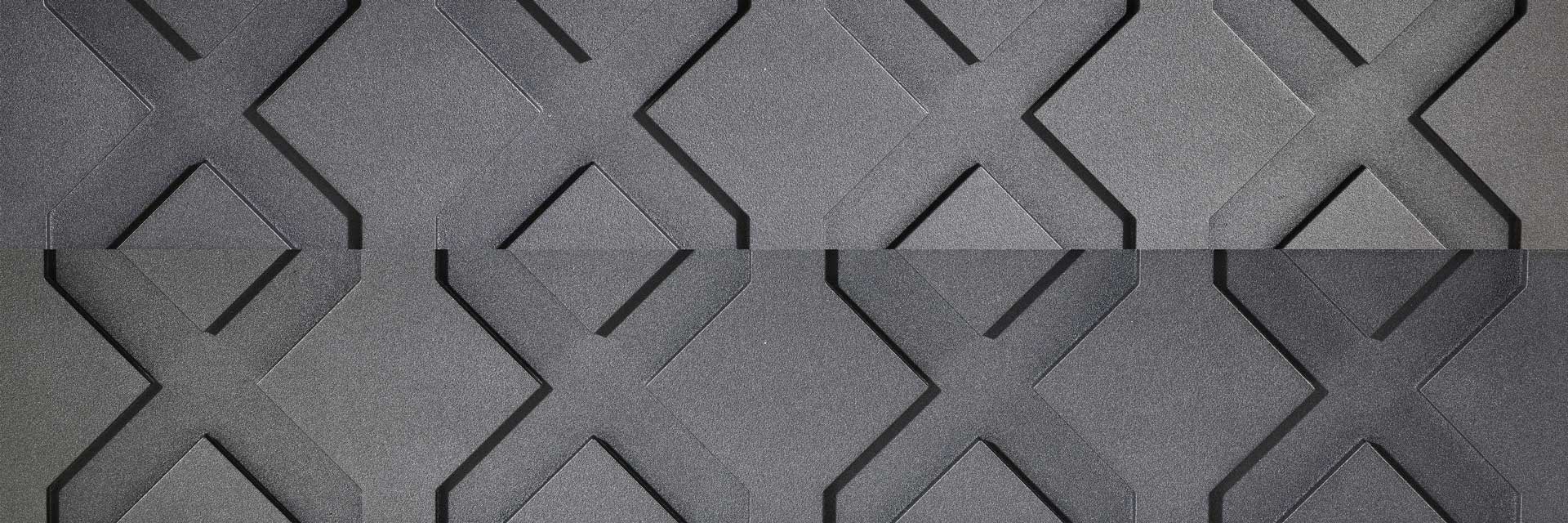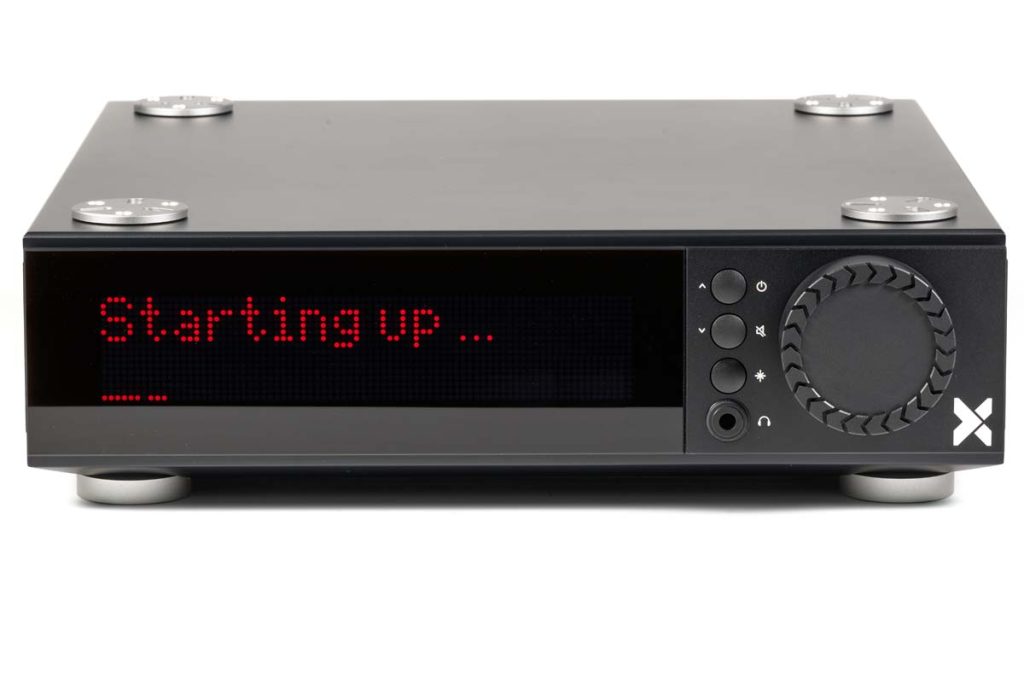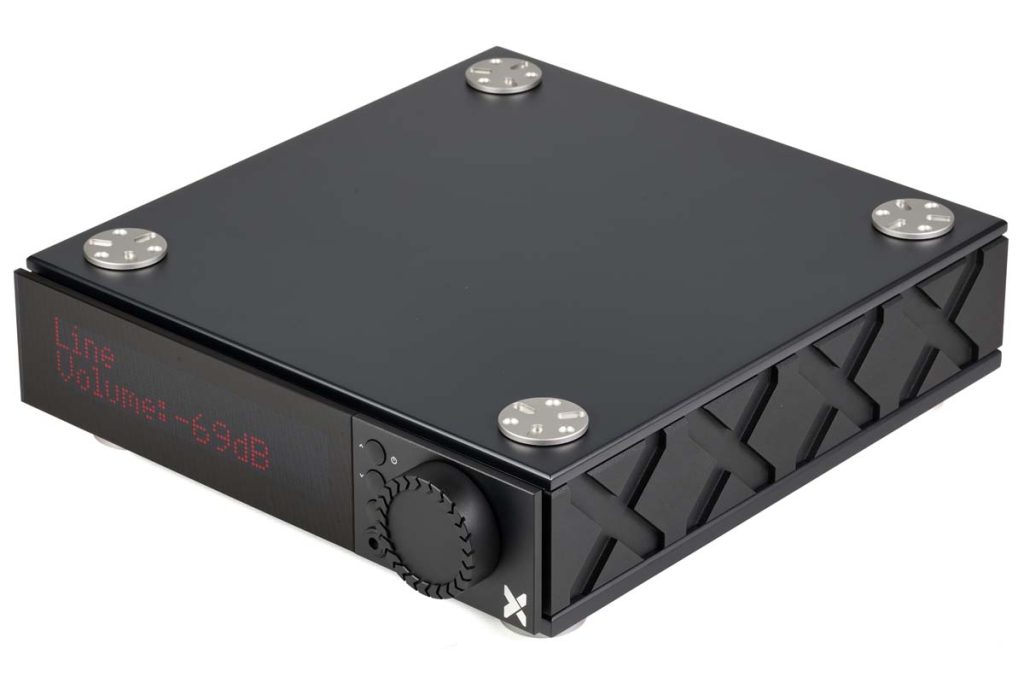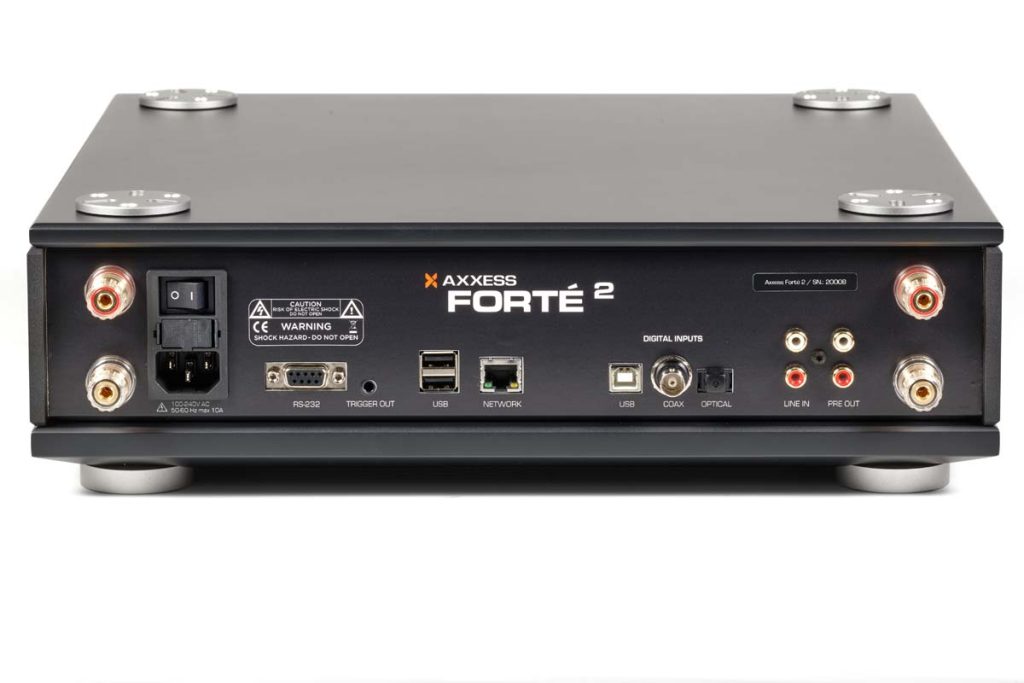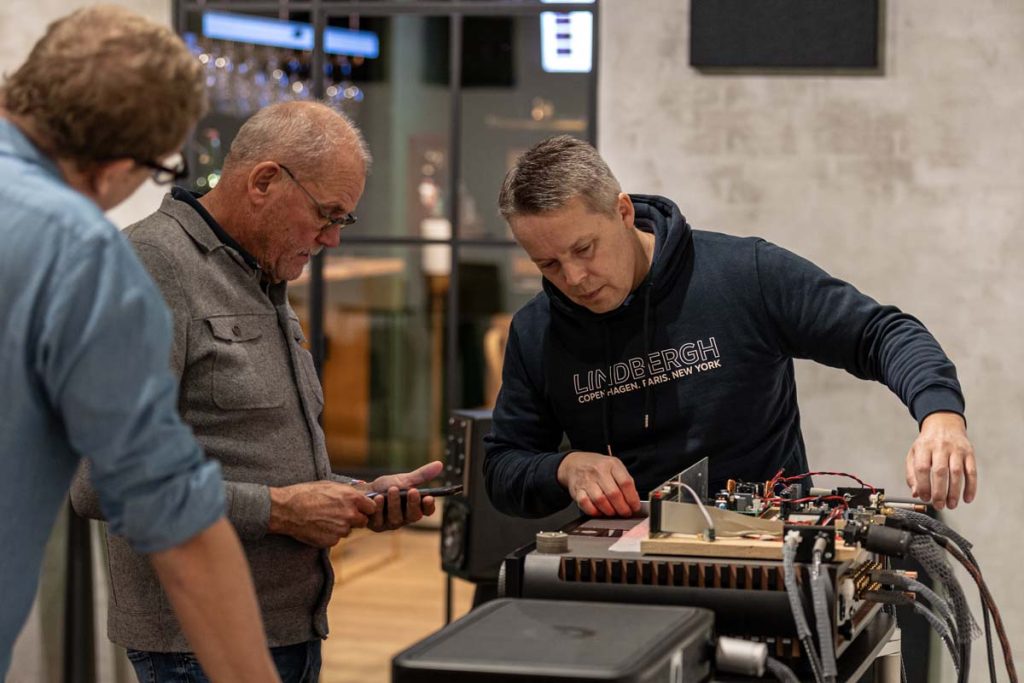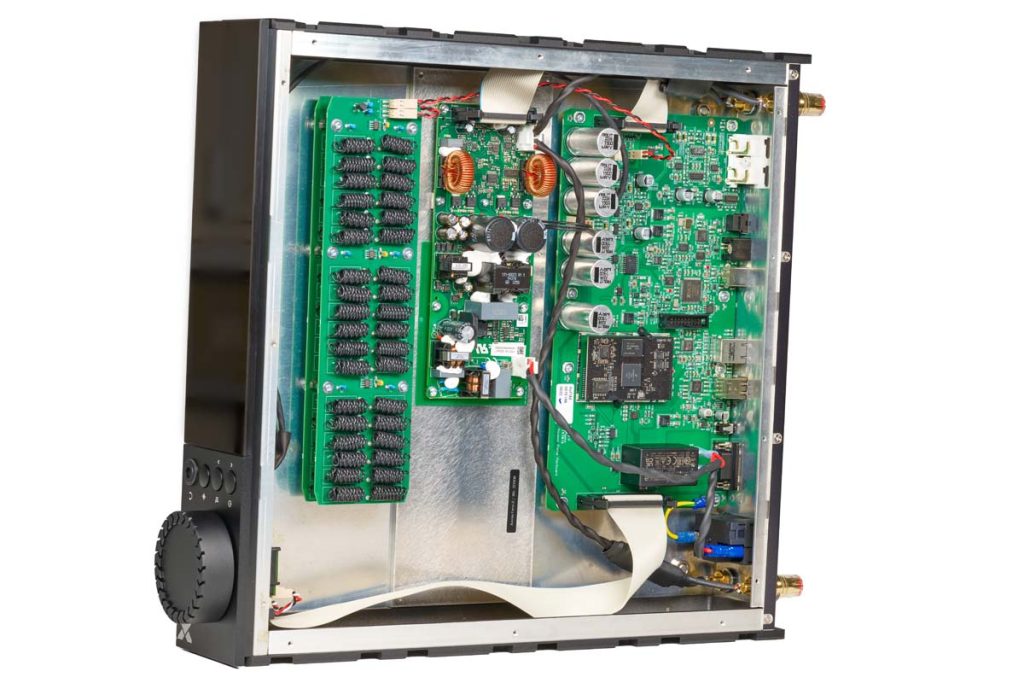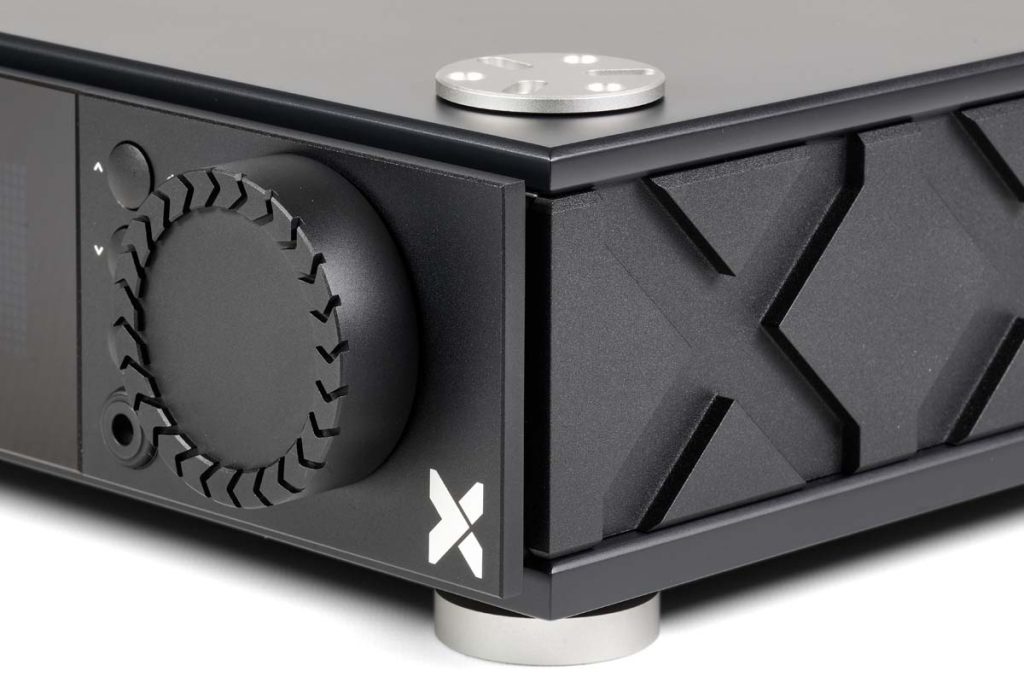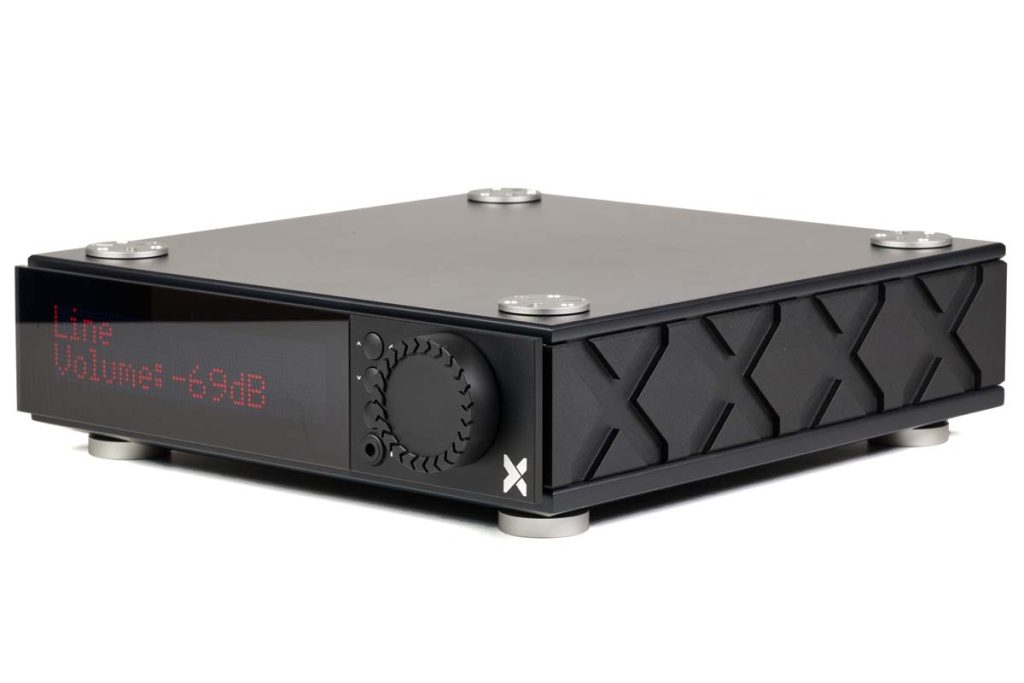Everyone is focused on the superlatives: powerful juggernauts with weighty price tags are unattainable, but they are a turn-on. And Audio Group Denmark (ADG) caters to this segment like few other manufacturers can. Now, however, the Danish upstarts have packed their greatest technologies into an affordable all-in-one package. Could the Axxess Forté 2 perhaps be the device of the year?
Visiting the north of Denmark is always a trip to the audiophile theme park. The halls of AGD provide insights into the sophisticated production of the four house brands: Ansuz, Børresen, Aavik and (most recently) Axxess. Moreover, they are peppered with excellent listening rooms and even a small pub. But if you look closer, dark nooks and crannies hold hints of what the high-end manufacturer is currently working on and researching. Michael Børresen and his team are far too busy for everything to be hidden away. For example, during our last visit in December 2022, we witnessed the sound tinkerers playing around in a tiny measuring booth with wideband classics from Celestion and the like. In a confidential conversation during our recent trip, Børresen was amazingly open: He’s currently working on a retro speaker, but he couldn’t reveal details, as everything remains confidential. Then he hopped from one foot to the other and finally hurried into the office for a folder with initial renderings – opinions, please.
All the ideas and thoughts pointed conspicuously in a single direction: with its complex manufacturing technology, haptic, optical and technical sophistication, as well as development times that can even take years, AGD’s price barometer is aiming up. We could see this quite clearly: the dominant theme during our visit was the 880 family along with its peripherals, which we have already presented in the form of the integrated Aavik I-880 or the Ansuz D-TC3 power distributor.
Perhaps to demonstrate that, in spite of all that, they’re still tapped into the market situation, we witnessed an interesting spectacle at the end of our visit, which we had to keep quiet about – until now. The developers carried a small wooden board into the listening room and placed improvised electronics on it, along with a display hot-glued to the back of an I-880. Moments later, Børresen’s top-notch compact M1s filled the room with blissful vibrations that dissolved us into the music. Whatever it was, its performance – judging by our first impression – was not far off the I-880. Perhaps a bit less polished and detailed, but in terms of timing and spatial imaging, the experimental unit was swinging with that unmistakable coolness characterizing all Aaviks. Yet we couldn’t delve much deeper into our impressions, as the apparatus quit after just a few tracks. That was foreseeable: Unlike the superb signal processing, the programming still consisted of an asynchronous hodgepodge of source codes. However, what did make us sit up and take notice was an aside from company founder Lars Kristensen: “We might bring this to the show as an all-in-one component, for something like 5,000 euros.”
The price alone may not sound like full-on consumer class, at least as small streaming receivers go. The devices of the Danes very much remain exclusive toys. Nevertheless, the sonic proximity to the I-880 character or to components like the Streamer S-580 made our ears perk up. Those who know the manufacturer’s big machines know exactly what I mean.
But of course, there was more to come than just a single component. At the last minute, Michael Børresen contributed to the complete system with an “I’d like to make one more addition or two”. And this resulted in Forté, as the beautiful child is now called, going on sale in a version 1 (around 5000 euros), version 2 (our sample, around 7500 euros) and version 3 (around 10 000 euros). The difference between the three translates to their other models. As the model number increases, each of the trio has an increasing number of Tesla and dithering circuits that are elaborately wound and soldered in by hand, and that incur corresponding costs. The Forté models are also manufactured locally in Aalborg. Our “number two” has no fewer than 72 active Tesla coils, 144 passive coils (printed on the board layout), four Tesla coils made of the precious wonder material zirconium and six dithering circuits. Whew! The smaller Forté 1 has approximately half of everything, and the largest about a third more – plus a solid, pure bottom copper plate, which it takes directly from the I-880.
So what’s the meaning behind all this? Allow me a digression. Michael Børresen uses the various Tesla and dither circuits to, as he says, tease more information out of the music. The coils modulate the signal in its entirety on the time axis. Just imagine a mountainous panorama with a tree blocking part of your view. You tilt your upper body first to one side, then to the other, so that you can see what is hidden behind it. We were cheeky enough to send one of our Ansuz Sparkz TC2s to the Gecom measurement lab, so that we could get to the bottom of the included circuitry. And the measurements revealed yet another effect: the Sparkz’s 12 coils add a small amount of noise under the music signal, the level of which is at the limit of what can be measured. Essentially this is a form of interference, but it smooths over more irregular disturbances and smaller resonances with its diffuse and thus harmonic structure. Imagine painting over a tiny flaw on a painting with a dab that matches the color of the painting. Simultaneously, this explains why many coils are better than a few: The more coils, the denser and more harmonious the noise. Finally, the prototype in the ADG listening room did not yet have a single one of these coils – a lone Ansuz Sortz on the cabinet back served as stopgap.
And here’s the proof: the kitchen board with electronics mentioned in the article really existed. This picture captures the moment when Lars Kristensen (center) tries one final time to contact the streamer of the “Forté 0”. Shortly thereafter, our session was over. The unfinished programming proved too stubborn for a longer listening test, but this is normal in the development phase.
Our snapshot shows the signal inputs and speaker outputs still arranged on the side at this stage. However, the ribbon cable for the system control already exists, in the lower third of our test device (left). In principle, the construction has remained the same: Even the prototype had a motherboard with all essential functions including the power supply and the small black streaming board. The power amplifiers were located on a separate board. However, the speaker signals remained routed via black/red twisted strands. Today, they are covered in black. Just before the speaker outputs, you can see two small black “knobs” in the Forté, much larger versions of which can also be found on the speaker cables and various signal strips from Ansuz. The prototype still lacked the two stacked circuit boards with the dither and tesla circuits – this task was fulfilled by a lone Sortz noise killer.
One last word about the case construction, shown clearly on the left: Like many of its Aavik predecessors, the Forté 2 sits in a metal tub wrapped in different materials on all sides. The upper and lower ends are formed by metal covers to which wooden panels are screwed. Only the power amplifiers sit on an additional, reinforcing metal frame – all of this serves to control resonance.
But now we have talked a lot without even a concrete word about the Forté 2. In principle, that’s not a bad thing, since the unit can be described quickly. All three Forté versions are completely identical apart from their coil density: They are streaming receivers with one analog input (RCA) as well as three digital inputs (optical, BNC and USB). Streaming is via LAN, and WLAN can be retrofitted with a standard USB dongle if necessary. The outputs are a pair of high-quality speaker binding posts, a regulated pre-out and a 6.3-millimeter headphone jack. The output power is an impressive 2 x 100 watts into 8 ohms, thanks to powerful Class D modules utilizing Aavik’s in-house UMAC formula, which allows the smart amplifier to handle even the trickiest speakers. Meanwhile, the headphone output is not just a toned-down variation of the main amplifier, but has its own Class A circuit with decent juice and minimal distortion. Even on a heavyweight like Dan Clark’s Expanse, the Forté sounds excellent, natural and dynamic.
The pleasing visual design was penned by Flemming Rasmussen and represents an edgier variation of Aavik’s 180/280/580 look. The cabinet boasts clean lines with intriguing details like the side panel “X” embossing. Coolest of all was the level control, whose “arrow” structure sounds a marching order: Louder! The cabinet’s design is also based on the Aavik models: The resonance behavior of the inner metal core is optimized by attached stringers (non-magnetic metal) as well as top and bottom wood layers. The feet and screwed-in upper foot mounts anticipate that each of the three Fortés are likely not the end of the story: The Axxess components are distinctly stackable.
If there’s anything to criticize about the concept, it’s the manufacturer’s lack of communication. The Danes are extremely forthcoming about the underlying technology, yet they’re just as silent about the DAC and streamer capabilities as they are about their Aaviks. We can confirm through trial-and-error that the Forté is high-bit capable. It plays 24/192 without issue. It also communicates with a wide range of UPnP/DLNA apps, responds to Spotify and Tidal Connect and Roon certification should soon follow. This may be part of the “convenient” concept: Simply press “Play” and don’t worry about anything else. Should the Forté handle details like MQA or DSD through tricks like DoP, it does so unobtrusively and flawlessly.
Regarding the sound, I have said everything important with the short impressions of our trip to Denmark. Although it says Axxess on it, there is a genuine Aavik in this cabinet. The Forté 2 makes stunningly calm and relaxed music – it reproduces sound stages elastically and tangibly without ever overdoing it. The room size strictly adheres to the specifications of the mix and master of the sound medium.
Tonally, the musical neutrality of the receiver cannot be praised enough: When I streamed Nick Cave’s “Idiot Prayer” during the test, the bard’s voice reverberated softly and smoothly through the room. You can physically feel the recording room: The eponymous album was captured in an empty concert hall, and you can grasp the dimensions and texture. Or roughly, at least, which is presumably to capture the reverberant emptiness. The album has a delightfully warm timbre that minimally dampens the highs but doesn’t swallow any details.
Immediately after that I do the cross check and play “Soma” by the Smashing Pumpkins (Siamese Dream). The ballad’s solo, like nearly everything the Pumpkins have recorded, is garnished with a fuzz distortion that scratches and stings and bites delightfully across the Forté 2. This reveal another characteristic of the receiver that I also appreciate in our 580 line reference components: The Forté reproduces audiophile recordings with attention to detail, pushing the capabilities of speakers like Wilson Audio’s Sasha DAW or Audio Physics’ compact Spark. And it cuts a fine figure – likely through the high power of its amplifiers – even when things get rougher and ultra-low frequencies fill the listening room. Especially with components that consider themselves “truly audiophile”, snotty grunge tracks or “loudness pop” of all eras can sound hissy and dull. However, the Forté 2 is a diplomatic all-rounder for the whole family and for all occasions – for this alone, you simply have to love it.
Accompanying Equipment
CD Player: Audio Note CD 3.1x/II, Ayon CD-3sx | Network Player/DAC: Aavik S-580 and D-580, Lumin X-1 | Integrated Amplifier: Aavik I-580 | Loudspeakers: Wilson Audio Sasha DAW, Audio Physic Spark, DALI Epicon 6 | Rack: Finite Elemente, Solidsteel
Network Receiver Axxess Forté 2
Concept: streaming receiver with Class-A headphone amplifier and Tesla technology | Inputs analog: 1 x RCA | Inputs digital: 1 x USB-B (PC, Smart Devices), 1 x Toslink, 1 x BNC (S/PDIF), 2 x USB-A (dongles) | Outputs analog: 1 x pre-out, single-wire loudspeaker binding post, 6.3 mm headphone output | Amplifier: 2 UMAC power amplifiers (Class-D) | Output power (8 Ω): 2 x 100 W | Features: over 200 Tesla and dither circuits, sandwich enclosure | Accessories: power cable, remote control | Finish: black | Dimensions (W/H/D): 37/11/42 cm | Weight: 8.1 kg | Warranty: 2 years | Price: around 7500 €
Audio Group Denmark
Rebslagervej 4
9000 Aalborg
Denmark
info@audiogroupdenmark.com

